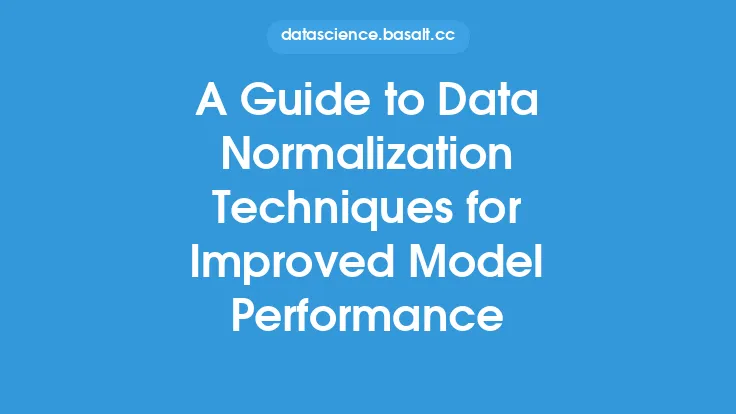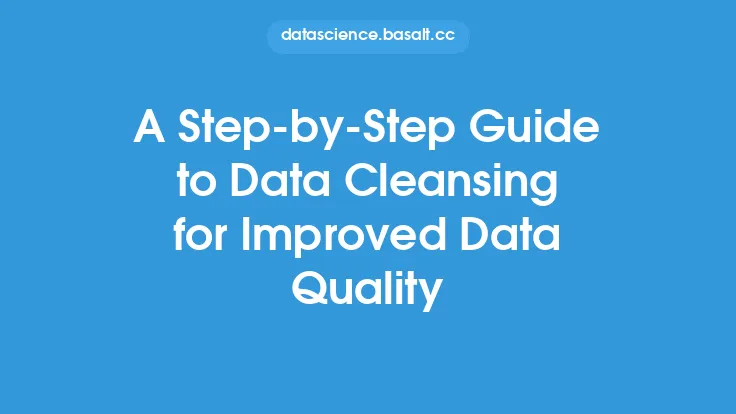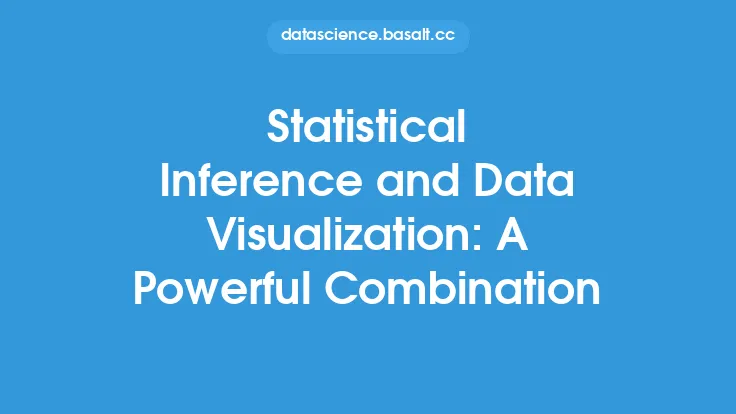Statistical inference is a crucial aspect of data science, as it enables data scientists to make informed decisions and draw meaningful conclusions from data. At its core, statistical inference involves using sample data to make inferences about a population or phenomenon. This is achieved through the use of various statistical techniques, which are designed to provide insights into the underlying patterns and relationships within the data.
Introduction to Statistical Inference Techniques
There are several statistical inference techniques that data scientists can use, depending on the nature of the data and the research question being addressed. These techniques can be broadly categorized into two main types: parametric and non-parametric methods. Parametric methods assume that the data follows a specific distribution, such as the normal distribution, and are often used for hypothesis testing and confidence interval construction. Non-parametric methods, on the other hand, do not make any assumptions about the underlying distribution of the data and are often used for tasks such as regression analysis and time series forecasting.
Hypothesis Testing
Hypothesis testing is a fundamental concept in statistical inference, and is used to determine whether a observed effect is due to chance or if it is statistically significant. The process of hypothesis testing involves formulating a null and alternative hypothesis, collecting sample data, and then using a statistical test to determine whether the null hypothesis can be rejected. There are several types of hypothesis tests, including t-tests, ANOVA, and regression analysis. Each of these tests has its own strengths and limitations, and the choice of which test to use will depend on the nature of the data and the research question being addressed.
Confidence Intervals
Confidence intervals are another important statistical inference technique, and are used to estimate the value of a population parameter. A confidence interval is a range of values within which the true population parameter is likely to lie, and is constructed using sample data. The width of the confidence interval will depend on the sample size, the level of confidence desired, and the amount of variation in the data. Confidence intervals can be used for a variety of purposes, including estimating the mean of a population, the proportion of a population that exhibits a certain characteristic, and the difference between the means of two populations.
Regression Analysis
Regression analysis is a statistical technique that is used to model the relationship between a dependent variable and one or more independent variables. There are several types of regression analysis, including simple linear regression, multiple linear regression, and logistic regression. Each of these types of regression analysis has its own strengths and limitations, and the choice of which type to use will depend on the nature of the data and the research question being addressed. Regression analysis can be used for a variety of purposes, including predicting the value of a continuous outcome variable, predicting the probability of a binary outcome variable, and identifying the relationships between variables.
Bayesian Inference
Bayesian inference is a statistical technique that is used to update the probability of a hypothesis based on new data. This is achieved through the use of Bayes' theorem, which combines the prior probability of the hypothesis with the likelihood of the data given the hypothesis. Bayesian inference can be used for a variety of purposes, including hypothesis testing, confidence interval construction, and regression analysis. One of the key advantages of Bayesian inference is that it allows data scientists to incorporate prior knowledge and uncertainty into their analysis, which can be particularly useful in situations where there is limited data available.
Resampling Methods
Resampling methods are a class of statistical techniques that involve repeatedly sampling from the data with replacement. These methods can be used for a variety of purposes, including hypothesis testing, confidence interval construction, and regression analysis. There are several types of resampling methods, including the bootstrap and permutation tests. The bootstrap involves repeatedly sampling from the data with replacement, and then using the resulting samples to estimate the variability of a statistic. Permutation tests, on the other hand, involve repeatedly permuting the data, and then using the resulting permutations to estimate the distribution of a test statistic.
Statistical Inference for Big Data
The increasing availability of large datasets has created new challenges and opportunities for statistical inference. One of the key challenges is that traditional statistical techniques can be computationally intensive and may not be feasible for large datasets. To address this challenge, data scientists have developed new statistical techniques that are designed specifically for big data. These techniques include distributed computing methods, such as Hadoop and Spark, and parallel processing methods, such as GPU computing. Additionally, data scientists have developed new statistical methods that are designed to take advantage of the unique characteristics of big data, such as the use of regularization techniques to prevent overfitting.
Common Challenges and Limitations
Despite the many advances that have been made in statistical inference, there are still several common challenges and limitations that data scientists face. One of the key challenges is that statistical inference requires high-quality data, which can be difficult to obtain in practice. Additionally, statistical inference requires a deep understanding of the underlying statistical techniques, which can be time-consuming to learn. Furthermore, statistical inference can be sensitive to the choice of statistical technique, and the results can be affected by the presence of outliers, missing data, and other forms of data quality issues. To address these challenges, data scientists must be careful to validate their results using multiple techniques, and to carefully evaluate the assumptions and limitations of each technique.
Best Practices for Statistical Inference
To ensure that statistical inference is performed correctly, data scientists should follow several best practices. First, data scientists should carefully evaluate the research question and determine which statistical technique is most appropriate. Second, data scientists should carefully check the assumptions of the statistical technique, and ensure that the data meets the necessary requirements. Third, data scientists should use multiple techniques to validate the results, and carefully evaluate the limitations and potential biases of each technique. Finally, data scientists should clearly communicate the results of the statistical inference, including the assumptions, limitations, and potential biases of the technique used. By following these best practices, data scientists can ensure that statistical inference is performed correctly, and that the results are reliable and accurate.





